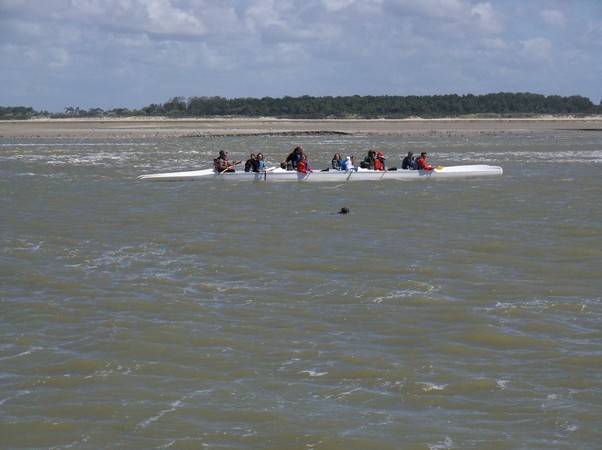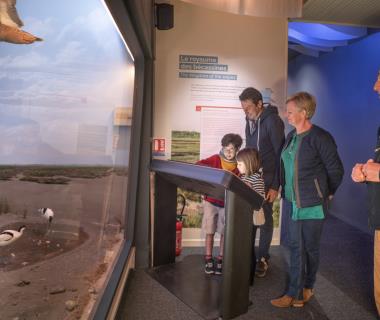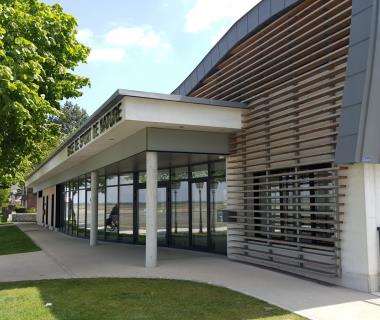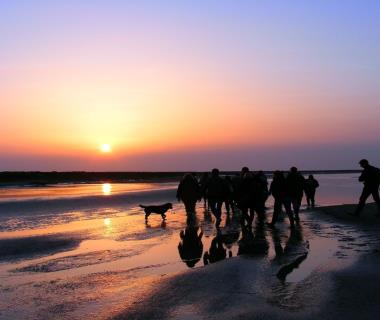The Somme Bay, a refuge for seals
- 400harbour seals
- 200grey seals
- 100kilos average weight
One of the largest colony
in the north of France
France’s largest colony of harbour seals has made its home in the Baie de Somme. Grey seals also live in the three estuaries situated on the Côte d’Opale and between Calais and Dunkerque.
The seals gather to rest on sand banks which emerge at low tide. For both species of seal, these twice-daily periods of rest are a vital part of their biological cycles throughout the year. Any humans venturing out onto the estuary must be respectful of this.
Should you get too close to them in the Baie de Somme, they will lift their heads when first startled. Stop where you are. If you continue towards them, they will take fright and escape into the water. It is recommended that you keep a distance of 300 m. In summer, female harbour seals which are disturbed too often may abandon their only offspring which cannot survive alone.
Every summer volunteers from Picardie Nature invest their free time to help prevent the seals from being disturbed in their resting places, alerting walkers, kayakers and riders to the need to respect the seals’ space as they rest.
 ©comdesimages
©comdesimages © Somme Tourisme - JM
© Somme Tourisme - JM ©SMBSGLP
©SMBSGLP © Somme Tourisme - J.M
© Somme Tourisme - J.M ©SMBSGLP-NHerrmann
©SMBSGLP-NHerrmann © Guillaume Crochez
© Guillaume CrochezGrey or harbour seals?
Two protected species in the Somme Bay
Picardie Nature counted 473 harbour seals and 151 grey seals in the Somme Bay, during the peak period in 2015. Numbers vary with the seasons and mammalian activity.
The harbour seal's coat ranges from light to silver grey with black spots. Some are black, dark grey or brown with white spots. They like to live in sheltered, sandy estuaries. They give birth in the sandbanks in July, during low tide.
The grey seal has a coat that's a darker shade of grey and speckled. Males have even darker coats. They like rocky coasts, which is why there are fewer in the Somme Bay. They give birth in December/January on the rocky coasts: it can be quite an amazing sight in the Somme Bay.
Picardie Nature
This association watches over and protects the Somme Bay seal colonies, as well as raising awareness and providing information.
Tel.: +33 (0)3 62 72 22 50
 ©Stéphane Bouilland
©Stéphane Bouilland © Somme Tourisme - J.M
© Somme Tourisme - J.M ©Stéphane Bouilland
©Stéphane Bouilland ©SommeTourisme-CP
©SommeTourisme-CPThe best spots
for watching them
Firstly, the seals are protected species. Anyone disturbing the animals during low tide can be fined, so make note of these tips to ensure their protection:
- The Pointe du Hourdel, during low tide, but you can't see the seals with the naked eye, so take binoculars or a telescope. It's best to make an appointment with Picardie Nature, in June, July and August. They are there every day during low tide.
- Authie Bay, during low tide: you can see them from the seawall. Park at the Berck lighthouse, then follow the signs.
- With a nature guide! Several Somme Bay associations and independent guides offer excursions to watch the seals safely. You can watch the colony without disturbing the seals, and the guides can answer all your questions!
- In the ports at high tide (especially in Saint-Valery-sur-Somme and Le Crotoy).
- During a canoe or kayak excursion starting in Saint-Valery-sur-Somme: it's the ideal boarding place to set out to meet seals without frightening them.

Let's talk ToLaetitia Dupuis
Seal Officer, Picardie Nature
En direct des Blogs !World Me Now
 ©World Me Now
©World Me Now


